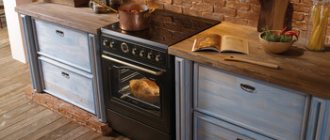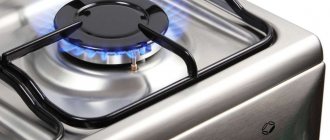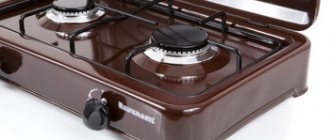Previously, in gasified houses, the gas stove was connected directly to the gas pipeline using a steel pipe. The method was considered safe, but caused some inconvenience. The main disadvantage of a rigid installation was the impossibility of moving the stove to a convenient position in order to properly organize the work area. A modern flexible gas hose for a gas stove is considered no less safe, but allows you to install the hob where it is convenient.
Only a correctly selected gas hose guarantees safe connection and reliable operation.
Manufacturers of hoses for gas stoves: TOP-6
| Photo | Name | Rating | Price | |||
| Rubber Gas Hose Manufacturers | ||||||
| #1 | MasterProf | ⭐ 4.95 / 5 9 — votes | More details | |||
| #2 | Aquaelka | ⭐ 4.9 / 5 53 - votes | More details | |||
| #3 | Bed | ⭐ 4.85 / 5 16 — votes | More details | |||
| Bellows Gas Hose Manufacturers | ||||||
| #1 | Tim | ⭐ 4.95 / 5 31 - voice | More details | |||
| #2 | UDI | ⭐ 4.9 / 5 5 — votes | More details | |||
| #3 | Overcon | ⭐ 4.85 / 5 29 — votes | More details | |||
Which plan would you choose for a gas stove?
Take the survey
A gas hose is a very simple and unremarkable, but very important product that is simply necessary in a house where there is a gas stove. It will determine how well, reliably and safely the stove will be connected to the gas main.
There are very, very many models and options of gas hoses, differing in length, materials of manufacture and other parameters, in any hardware or construction store. To be convinced of this, just go to some Maxidom and just find a shelf with the corresponding goods. So it’s simply pointless to consider specific hose models. It is better to try to find out the names of manufacturers that you can trust.
Our list below features six manufacturers of rubber and bellows gas hoses. It is these two varieties that are considered the main types of eyeliners used today. Let's get to know them.
Important! Let us remind you that the opinion of the site’s editors cannot be considered the only true and correct one. Readers' opinions may vary. The list of manufacturers was selected based on the popularity of their products and customer ratings.
Reliable signs of a fake
Regardless of the type of flexible gas hose, you should ensure the authenticity of the product before purchasing. The fact is that recently cases of defects and counterfeits launched for sale by Chinese manufacturers have become more frequent.
Well-known European brands are usually the targets of counterfeiting. The difference in quality between the original and the fake can be colossal.
It is possible to play it safe and distinguish a quality product from a counterfeit one.
To do this you need:
- take the time to conduct a thorough visual inspection;
- check whether the technical characteristics correspond to those indicated in the product passport;
- require the seller to present quality certificates confirming the safety of the device intended for working with explosive substances;
- do not buy goods at a suspiciously low price, which is not typical for products in this category.
The structure of counterfeit goods may contain dangerous chemical or radioactive impurities. Defective hoses are short-lived and often cause explosions.
Rubber Gas Hose Manufacturers
No. 3 - Bed
Gas hose Ruslo
This company has been active in the Russian market for more than 10 years. Previously, it only sold various components that helped ensure water and gas supply, but now it has launched its own production of gas connections, which is located in St. Petersburg.
Ruslo products are certified and comply with all GOST requirements and standards, and have various documents confirming quality, reliability and safety. The brand actively cooperates with gas services, contractors, and a number of construction organizations.
Gas hoses produced by this brand are inexpensive, reliable, meet GOST requirements, made of dense reinforced rubber, but flexible and easy to connect. They are protected from sparks and ignition of gas passing through them. Now such hoses can be bought in all stores in large gasified cities of the Russian Federation.
pros
- Russian brand
- have all certificates
- safety
- Availability - you can buy it in any store
- thick reinforced rubber in hoses
- the hose does not require a dielectric insert
Minuses
- not detected
Prices for gas hoses Ruslo
rubber gas hoses Ruslo
No. 2 - Aquaelka
Aquaelka gas hose
This brand is also Russian, and it also specializes in the production of flexible hoses for water and gas supply. Production is located in Podolsk. The brand has been on the market for more than 20 years. All this time he has been engaged only in the production of gas hoses, flexible connections, siphons, hoses for washing machines, so he has a lot of experience.
The production of hoses here is fully automated and takes place on the latest generation Spanish equipment. The productivity of the enterprise and the quality of products are at their best. Moreover, the brand is already trusted by some other countries - products are also sent abroad. You can safely buy gas hoses from Aquaelka without worrying that they will let you down.
pros
- Russian brand
- cooperates with other countries
- been on the market for a long time
- quality products
- favorable cost of hoses
- strict quality control
Minuses
- not detected
Prices for Aquaelka gas hoses
Aquaelka rubber gas hoses
No. 1 – MasterProf
Gas hose MasterProf
This company is still one of the leaders on the Russian market when it comes to regular supplies of various types of plumbing fixtures. Moreover, the brand is quite young - it appeared in 2012. He is committed to cooperation with DIY networks in the Russian Federation, including the famous Castorama, Leroy Merlin, Petrovich, etc. There are about 70 networks in total.
MasterProf production is massive, automated, working without interruptions. This is what allows him to not interrupt the supply of hoses to large stores. At the same time, the quality of the product does not suffer at all, and the price is reasonable. There are all the necessary certificates confirming the reliability of the hoses, and the manufacturer also provides a long warranty period of two years on them. This is why customers trust the brand: its products are chosen by ordinary city residents, construction companies and a number of other organizations.
pros
- long warranty
- one of the largest suppliers
- cooperates with large chain stores
- good price for the product
- high reliability
Minuses
- not detected
Prices for MasterProf gas hoses
rubber gas hoses MasterProf
Reviews about MasterProf gas connections
Safety precautions
Any installation work carried out with gas appliances requires mandatory compliance with all safety requirements. The connected flexible hose must always be in front of your eyes. It is strictly forbidden to close it. It must always be located in a place accessible for visual inspection.
It is prohibited to use a gas hose of non-standard sizes. They must comply with existing regulations.
The hose does not need to be painted, as paint may cause it to crack quickly. If you want to make the appearance of the sleeve more beautiful, you can cover it with self-adhesive paper.
The rubber hose is directly connected to the tap if it is located on the outlet. If the thread has non-standard dimensions, an adapter may be used.
When operating gas equipment, it is very important to comply with safety rules and existing operating standards. The fire safety of gas-fired installations depends on this
Bellows Gas Hose Manufacturers
No. 3 - Overcon
Gas liner Overcon
This is a Russian brand, despite the English spelling. It produces high-pressure metal hoses, heated floors, as well as connections for gas and water supply.
Bellows-type supply hoses produced under this brand are often used to connect gas stoves. They are distinguished by good flexibility and at the same time strength, they can stretch well and return to their original shape. However, before using such a liner, you must acquire a dielectric and install it between the liner and the riser. The warranty provided by the manufacturer for its products can be up to 25 years.
pros
- long warranty
- Russian brand
- excellent flexible hoses
- compliance with all quality standards
- famous brand
Minuses
- not detected
Overcon gas hose prices
flexible gas connection Overcon
No. 2 - UDI
Gas hose UDI
One of the largest suppliers of various engineering components and materials that are used for the installation of gas and heating equipment, as well as for organizing water supply. On sale are valves and fittings, fittings and siphons, corrugations and, of course, hoses of various types, including one of the most popular - bellows for gas communications. UDI not only produces, but also supplies various materials necessary for connecting this or that equipment, and cooperates with a number of stores and service centers, in most regions of Russia.
Bellows hoses from UDI are reliable, safe and inexpensive. They comply with all GOST requirements and are ideal for both independent connection of the stove to gas communications at home and for professional use.
pros
- major supplier
- produces various products
- high quality products
- compliance of hoses with GOST requirements
Minuses
- not detected
Prices for UDI gas hoses
flexible gas connection UDI
No. 1 - Tim
Gas hose Tim
The TIM company is a trademark that has been producing various plumbing fixtures, pumps, materials used for heating installations, as well as bellows hoses for connecting to gas mains for 10 years. Its product range is very large, and everything that the company sells is of high quality.
Now TIM is one of the leading companies on the Russian market. The production employs experienced specialists who support the operation of the enterprise at a high level. Moreover, they manage to combine European quality and Chinese efficiency.
The brand's products are not afraid of corrosion, are reliable and can be used in difficult environmental conditions. Moreover, the cost is moderate and will definitely not scare away the buyer.
pros
- famous brand
- large range of products
- European level quality
- customer trust
- experienced specialists at the enterprise
- products can be used in difficult conditions
Minuses
- not detected
Prices for Tim gas hoses
flexible gas connection Tim
Reviews of Tim gas hoses
How to choose
Before you start buying a hose for a gas stove, you need to pay attention to a number of points and listen to some recommendations.
Gas hoses should be purchased in specialized stores that specialize in the sale of gas equipment. Such establishments, as a rule, work with trusted suppliers and sell only certified products. In addition, sales consultants have sufficient knowledge and are well versed in the intricacies of connection. Often in special stores you can submit an application for connecting a gas stove, which will be carried out by trained people
Gas hoses should be purchased in specialized stores that specialize in the sale of gas equipment. Such establishments, as a rule, work with trusted suppliers and sell only certified products. In addition, sales consultants have sufficient knowledge and are well versed in the intricacies of connection. Often in special stores you can submit an application to connect a gas stove, which will be carried out by people trained in this.
In general, the requirements for the materials from which gas hoses are made are much higher than the requirements for the production of the same water hoses. This is because gas hoses need to withstand the very low temperatures encountered when transporting liquefied bottled gas. In addition, gas models should not burn themselves and support combustion, and also have a left-hand thread.
However, the most important requirement for gas hoses is the presence of an insulating insert, which was already mentioned above. The fact is that to increase the anti-corrosion resistance of steel gas pipes located in the ground, they are given a positive potential. And there is no guarantee that one of the residents of the apartment building did not use the gas riser as grounding for their household appliance.
This situation can lead to a short circuit, heating the metal braid of the hose and creating an explosive situation. In addition to the possibility of a spark occurring in the gas pipeline and detonation of the gas-air mixture with dire consequences, a person standing at the stove can receive an electric shock, and with a significant potential of stray charges, even serious electrical injury. To prevent such situations, the set of rules SP 42-101-2003 regulating the equipment of gas distribution networks included clause 6.4 on the mandatory equipping of internal gas pipelines with dielectric inserts, which must be installed even on polyethylene hoses.
Today there are two types of stray current cutoffs. The first is represented by dielectric couplings (MD), made in the form of an insulating fitting, equipped with threads on both sides. Couplings are mounted between the main valve and a flexible hose, and are the most common type of insulator. Dielectric couplings are available in four thread sizes: 1⁄2, 3⁄4, 1 and 1 1⁄4. This variety of diameters makes dielectrics compatible with any type of pipeline fittings used in intra-house networks. Moreover, couplings are available with thread/thread, nut/nut, and thread/nut ends, which makes selecting the right fitting much easier and allows you to adapt to any type of connection.
What hoses are needed for gas stoves?
A gas stove is a technique that allows you to use regular natural gas for cooking. True, it makes sense to use this type of household appliance like a gas oven only in gasified cities. However, even if there is no gas line in the house, you can also use liquefied gas cylinders as a source of fuel.
A household stove that runs on gas is equipped with several burners and may also have an oven. A gas burner is supplied to the burners, and there is also a gas distribution device that directs fuel to one or another burner. The flame can be adjusted using special levers that change the rate of gas flow into the burner. You can light the burner with any open flame source; there are also options for stoves with automatic ignition, which uses a spark ignition system using electricity.
This is what a gas burner looks like
Attention! Gas is dangerous! Or rather, it is dangerous not in itself, but because of its ability to instantly ignite. It is important to prevent gas leakage from the line to avoid an accident. Fortunately, modern stoves are able to automatically stop supplying fuel if, for example, the burner goes out. But, nevertheless, it is very important before using the oven to check that the entire system is connected correctly, securely and safely.
Immediately after purchasing a brand new gas stove, it can already be connected to the gas supply line. There are special services that do such work, but they will need to pay for the service. That’s why many people decide to connect the stove themselves, especially since the procedure seems very simple at first glance. But, like any job, it has its own nuances.
It is interesting that previously gas stoves were simply soldered tightly to the gas source pipe, without requiring any more connection options. Moreover, this method of connecting slabs was used only about 30 years ago. It was safe, but very inconvenient - it was impossible to wipe the floor under such a stove; if necessary, it was impossible to move it, well, and if it came to replacing the kitchen set, then it was a sad story. So when special thin and flexible hoses began to be used when connecting gas stoves, the joy of gas stove owners knew no bounds.
The process of connecting a gas stove to the mains
Now a special flexible hose is used to connect the gas stove to the main line. It has fittings (nuts and fittings) on one side and the other, which make it possible to obtain reliable connections both with the place where the gas exits the line and with the place where the gas enters the furnace. Such a hose can be made from different materials, but in any case it is flexible, strong, durable and, most importantly, inexpensive.
Connecting a gas stove to the mains using such a hose is the work of an experienced specialist. Otherwise, there is a high risk that the connection will be incorrect, which means that the likelihood that the entire kitchen will fly up into the air increases. Gas is no joke; you need to work with it with extreme caution.
No one will stop you from trying to connect the stove to the mains yourself. If you have some experience working with various connections, and also taking full responsibility upon yourself, you can easily buy a hose that suits the parameters and connect the stove yourself. The main thing is to take a responsible approach to both the work itself and the choice of hose.
Installation and connection
Often gas hoses come on sale with gaskets, but not in all cases. The user should connect the hose to the device and connect the device and the gas riser together, using various components. The angle when working must be correct and comply with the standards.
In order to correctly connect the coupling or bushing with the tap at the junction of the gas pipe and hose, it is worth performing a number of steps one by one.
- Shut off the gas supply.
- Leave the burners open to ensure complete combustion of the gas.
- Prepare several adjustable wrenches.
- Using the first key, you need to support the tap located on the tube, and with the other, unscrew the nut on the flexible device.
- Screw the hose nut to the end of the coupling.
- Carry out a thorough check of the seal quality. This is done by applying a soap solution using a brush.
- After all the above steps, it is necessary to open the valve and check the operation for the absence of bubbles.
Installing clamps on gas hoses does not require any special skills.
It is important not to forget to follow these rules:
- maintain the correct distance between devices;
- using a screwdriver, you need to tighten the clamps, but do not overdo it;
- It is worth inserting a main element into each of the clamps;
- Pull the bolts through the holes, screw in the clamps, ensuring a tight fit.
The diameter of the gas hose fitting 9 mm must have a 3/8″ thread, and the nut must be made of steel. It would be optimal to install a fitting made of brass.
Hoses for gas stoves: types and sizes
The hose that connects the familiar gas stove and the line that contains the gas looks like a regular water supply. But it has a special mark that allows you not to confuse the products with each other - these are white or yellow markings (the latter option is more common). Moreover, the marking should be very clearly visible.
The fuel hose is made from different materials and, depending on this, acquires certain properties. But in any case, the product will be flexible and convenient. Let's get acquainted with the types of gas hoses.
Rubber gas hose
Rubber hoses are variants of products that, as you might guess, are based on rubber; they are made from this very material. Rubber is one of the best dielectrics in nature, meaning it does not conduct electricity. But the service life and strength of a hose made from it is low. Typically, the rubber used to make products contains various components that add elasticity to it and extend its service life. But still, this does not change the fact that the rubber begins to crack over time, and the hose becomes dangerous for further use.
Rubber Braided Gas Hose
In turn, rubber hoses can be divided into two subtypes.
Table. Subtypes of gas liners made of rubber.
| View | Description |
| Rubber-fabric | These are the simplest and most inexpensive hose options available. These eyeliners are very soft, made of rubber and dense textile thread that seals them. They are easy to install, they perfectly insulate electricity, so sparks will not reach the gas. Also, such eyeliners are highly flexible. Such hoses must have markings - for example, a yellow label. It will inform the buyer that the product is intended for gas. Rubber hoses are available in large quantities in stores and have a variety of sizes - from diameter to length. Among the disadvantages, it can be noted that such a hose is easy to damage, it is practically not protected from changes in temperature (it can withstand heating of no more than 50 degrees). In addition, the rubber hose itself is short-lived - it cracks and begins to leak gas (leakage occurs). Therefore, such hoses are usually connected to gas cylinders with the condition that the product is regularly replaced every couple of years. |
| Metal braided | These hoses are also made of rubber, but on the outside they have a metal braid that reliably protects the product from damage. Metal braiding is created from many steel threads. But it is important to understand that inside is the same soft rubber, which still quickly collapses, or also a rather fragile polymer. Also, steel braiding is an electrical conductor. You need to handle such a product even more carefully than with a regular rubber version. And they must be connected using dielectric inserts. A gas hose reinforced with metal braiding is also inexpensive and easy to install. But, like rubber ones, it cannot be heated by more than 50 degrees. However, such hoses are more popular than ordinary rubber ones. It is easy to distinguish them from water ones - a yellow thread is woven into the outer braid. |
Oxygen gas hose
There is also an oxygen hose - also an inexpensive, but durable and pressure-resistant line option up to 20 atm. But it is rarely used in apartments. The fact is that such a hose is not suitable for organizing supply to various devices. Usually it is used only for temporarily connecting equipment to a gas cylinder somewhere in the country (it is necessary to additionally use a reducer to ensure sufficient safety). This option must be handled very carefully.
Stainless Steel Bellows Type Gas Hose
The next type is a bellows hose. It is also flexible, but is considered the most durable, safe eyeliner option. Moreover, it can shrink and unclench, change its size. The optimal solution for those who do not want to frequently change gas hoses or worry about fuel leaks.
On a note! A bellows is a corrugated shell made of metal or other material that has high density and strength and maintains good performance characteristics in almost any conditions.
The bellows hose is sealed and made of polymers and steel, additionally reinforced with an annular or screw corrugation. The corrugation, in turn, has a wire in its design - this allows it to withstand very high pressure if necessary.
The fittings that end the line are made of brass or steel, have threads and reliable gaskets that will ensure a reliable and safe connection.
Bellows gas hose fittings
On a note! Manufacturers of bellows hoses report an interesting fact: such a hose has exactly the same structure as the human intestines. So, thanks to this factor, the hose easily changes size, stretching, bending in every possible way, becoming longer or shorter. At the same time, the product does not lose its quality and does not become less elastic. But remember that you should not stretch the hose more than 50%.
Advantages of a bellows hose:
- not afraid of electric current (up to 1500 V);
- easily copes with pressure up to 6 atm;
- easily changes its size and returns to its original parameters;
- not afraid of chemical or moderate physical impact;
- safe;
- serves for a long time (up to 30 years);
- reliable;
- compatible with various equipment;
- has good density, but is flexible;
- withstands heating up to +250 degrees and cooling down to -50.
By the way, the bellows hose often also has a thermal protection valve, which, if the temperature rises too high, easily cuts off the gas supply. The color of the bellows product in a polymer shell is bright yellow.
Bellows gas hose with markings
These are the options that professionals involved in connecting gas furnaces recommend using. They even meet European requirements regarding quality and safety (in Europe it is completely prohibited to use conventional rubber products). But there is also a very significant drawback - the relatively high cost of the products. But it is suitable for connecting to a gas water heater, a boiler, a stove, etc., and is manufactured on the basis of GOST. Can be used even outdoors or indoors with large temperature changes.
What else you need to know about bellows eyeliner
Today you can purchase a flexible connection for a mixer in a store of relevant goods; this also applies to bellows connections, which, although expensive, have found their way among consumers. This product is a corrugated hose made of stainless steel. At the ends there are fittings made of stainless steel. Such a line must be fixed to the gas inlet pipe or equipment using union nuts. Be sure to use metal gaskets, which must be soft, this includes aluminum or copper. Special plastic can also be used as a gasket material.
This flexible stainless steel line can have corrugations and fittings made of different materials. However, experts recommend purchasing products that are entirely made from the same base. This requirement is due to the fact that welding different metals can cause an electrochemical reaction, which contributes to the destruction of the weld. Such a connection cannot be called strong.
Gas hose sizes
If we talk about sizes, gas hoses in the store are sold in a variety of lengths. This will allow you to competently, accurately and correctly connect the stove to the main line without violating any requirements. Yes, yes, there are certain requirements for the length of the flexible type of supply hose that is used to connect the slab and the main pipe.
So, according to a number of regulatory documents, to connect the stove to the gas main, a flexible type liner with a heat resistance of at least 120 degrees can be used, without unnecessary joints and connections. But as for the length, there are restrictions only in Europe, but in Russia they are not yet available. In European countries, the length of the hose cannot exceed 2 m. But in our country, you should not abuse the absence of a specific ban: the matter, first of all, is for your own safety. It is best to limit yourself to the same 2-3 meters and not tempt fate.
Calculate in advance how long the gas hose you will need
Sometimes specialists who come to you to connect the furnace suggest increasing the length of the gas line itself. But this is an expensive service that gives them the opportunity to make money from you.
It is also important to consider the following aspects of installing a flexible gas hose.
- it must be available for regular inspection for integrity;
- bends and pinching should not be allowed;
- the hose should not be mounted in such a way that it is under tension during use;
- The hose should not be placed where there is high humidity (for example, behind a sink). There is a risk of corrosion.
Important! The gas shut-off valve must be located on the horizontal part of the gas pipe and be at a distance of at least 20 cm from the stove. If the wiring is from above, then the faucet is installed at a height of 1.5 m from the floor on the descent to the stove.
If necessary, you can become familiar with the rules and regulations for connecting furnaces to mains by reading the official document. This is SNiP No. 42-01-2002 dated 03/01/2005. "Gas distribution systems".
Requirements for gas hoses
A flexible hose for gas supply, in contrast to connecting equipment to metal pipes, allows connection to be made in a short time with the possibility of further movement of the device.
The gas supply hose must meet the following requirements:
- Withstand the pressure in the main line. Compared to water, the pressure in the gas line is much lower and usually does not exceed 0.03 bar.
- Ensure a tight connection to the threaded pipes of the stove and the gas pipeline. For this purpose, the hoses are equipped with American-type threaded nuts and fittings with external threads. Typically, the sizes of gas line fittings are measured in inches, the most commonly used diameters are 1/2 and 3/4, less often 3/8 inches.
- Maintain the entire service life without damage to the shell or loss of tightness.
- Be flexible enough so that the bending radius allows, when connecting to the stove, to install it in the most convenient position closer to the wall.
- Withstand elevated temperatures in the slab area for a long period without changing the structure of the shell.
Rice. 2 Rubber-fabric hoses
Choosing a hose for connecting a gas stove
The choice depends on a number of factors. For example, you need to consider where the stove will be placed, under what conditions it will be used, etc. But the basic requirements for eyeliners do not depend on their type:
- Inspect the selected option for integrity.
- The protective coating on the outside should also be intact and generally exist.
- Be sure to check that there are no unnecessary connections or extension cords.
- If the hose has a metal coating, check if the braid is rusty.
- There must also be a yellow mark on the hose. It is she who will inform you that the product is designed to work with gas.
The sizes of gas hoses are very different.
The sizes of the connections can be different. The most common ones are 1-1.5 m. It is not worth buying a product with a large margin of length - it is enough to add 20 percent of it to the value obtained during preliminary measurement.
There can be different types of connections at the ends - nut-nut or nut-fitting (female-male). They usually have ¾ or ½ inch threads. The fitting has a thread on the outside, the nut on the inside. You need to choose the type of connection depending on what gas outlet is made on the stove itself.
Experienced gas workers recommend buying a product with an internal diameter of at least 1 cm, if we are talking about the bellows version. Then the gas will be supplied evenly even when all burners (4-5) are operating. And the larger the diameter of the hose, the better.
Advice! Buy gas hoses from trusted and reliable stores that work with honest suppliers. Then the risk of running into a fake is minimal. And you can’t just determine the latter by eye.
As a budget option, you can buy a rubber-woven hose. But we still recommend choosing bellows as a more reliable and durable option. The rubber one is suitable for temporary connection.
Bellows connection for gas
Most importantly, no matter what hose you choose to connect the stove, it is important that the product has all the relevant certificates, markings, and the date of manufacture. Moreover, the certificate must be issued by Rostechnadzor of the Russian Federation. If there is no such certificate, then the product may not meet all safety requirements. As for the date of manufacture, this is a very important point: for example, a hose that has rubber in its structure has an expiration date. If it expires, the product becomes unreliable. Usually such information is in the product passport.
Conclusions and useful video on the topic
The following video will talk about how to choose the right gas hose to connect the stove:
Considering all of the above, choosing a hose for connecting a gas stove is a very responsible task, in which savings should not be placed above safety. By carefully studying all aspects, you can choose and buy the best gas hose for your stove without overpaying, but also without putting yourself, your family and your neighbors at risk.
Which gas hose for connecting the stove did you choose and why? Please tell other visitors to our site about this. Write your comments, ask questions, share your experience - the contact block is located below.
Gas stove connection diagram
When the necessary hose has been purchased, you can either invite a specialist or try to connect the gas stove yourself. First you need to find the outlet that the household appliance itself has, and see what shape it is - it can be angular or straight. It is worth paying attention to this - the hose should not bend during operation! If the outlet is straight and the main pipe is located to the side, then you will need to purchase a special elbow with thread. When connecting, do not forget to use a special gasket made of paronite, a thin composite material. By the way, the paronite gasket comes complete with the hose. The product is screwed tightly to the outlet with an open-end wrench, but you shouldn’t be zealous. The gasket will reduce the risk of gas leakage.
Gas stove connection diagram
Advice! It is recommended to buy the gasket yourself in the store rather than use the one in the kit. The best option is with a fine metal mesh. This gasket will protect the oven from a number of contaminants.
By the way, the gas pipe is usually located somewhere in the corner of the kitchen. And a ball valve is welded to it, to which our hose is ultimately attached. The hose nut is screwed onto it.
It is important to check for fuel leaks. To find out whether it is there or not, you need to take soap foam, apply it with a brush to the joints and turn on the supply. No bubbles - no leakage.
Correct installation diagram for a gas stove
Security basics
And finally, there are a few aspects that need to be taken into account when using a gas hose. They are the key to your safety.
Observe safety requirements when connecting the gas hose
- The liner should be positioned so that it can be reached at any time.
- You cannot cover or curtain the hose with anything “for beauty”.
- It is advisable to regularly clean the product from dust and debris.
- The hose must not be placed under tension; it should sag slightly.
- If the stove suddenly needs to be moved, it is important to close the gas supply ball valve before doing so.
- Do not bend or twist the hose.
- No additional joints or extensions should be made.
- You cannot weld or solder the hose to the outlet of the line.
- It is necessary to regularly change the product to a new one, focusing on the period of use of the installed version.
- You need to make sure that the eyeliner does not lie in a damp place where it may begin to rust.
Installation recommendations
Experts advise following several rules when attaching gas hoses:
- to avoid kinks, tension or twisting, in order to connect the hose to the plate without compromising its integrity, you should select a bending radius of the part equal to three diameters of the hose used;
- the length of the part is selected taking into account the required distance, so that it is possible to move the equipment if necessary, and the type of product that was chosen, with some supply of hose for the gas stove, so that unnecessary stress is not created in the structure;
- the place must be accessible for inspection of parts;
- there should be no extraneous connections on the device;
- the product cannot be painted to prevent surface cracking;
- connections are made using metal tips;
- parts should be protected from condensation causing oxidation.
Regardless of which hose you connect to the gas stove, you should use the electric ignition very carefully.
What to consider for connection security
To safely connect and use the equipment, you should follow some rules:
- whatever the hose is to connect the gas stove, its location must be freely accessible so that it is not blocked by foreign objects;
- You should not replace the hose on a gas stove with your own hands; it is better to invite a gas specialist;
- connecting equipment with a flexible hose must be carried out in strict compliance with safety requirements;
- after connecting, the hose should sag slightly, without tension;
- the element must not be bent or twisted;
- the part cannot be painted;
- It is worth replacing the element a little earlier than the time for which it was designed; you cannot wait until a gas leak begins at the stove and then change the hose.
Replacement of the liner must be carried out by specialists licensed for such activities. They also periodically check the functionality of the equipment.
What do you need to consider for connection security?
Gas is not something to joke about, so it is better to entrust the work to a professional who is familiar with all the nuances. But if you familiarize yourself with the basic rules, you will be able to control its work from the outside, and when the opportunity arises, you will be able to show off the knowledge you have acquired. So:
- In order not to encounter problems in the future, you need to estimate in advance how far you are going to pull out the stove in case of, for example, cleaning. The length of the required hose depends on this.
- The product must be visible so that it can be constantly checked.
- Excessive tension, bending and twisting are unacceptable.
- Exposure to high temperatures is excluded.
- The elements are connected to each other only this way: copper to brass, steel to steel.
- They are tightened tightly, but not too enthusiastically, otherwise the thread may be damaged.
Now you have learned about gas hoses for gas stoves: which one is best for you? If you value reliability and durability, then there is only one way out - buy a bellows product that will provide you with safety, and therefore comfort for a long time.
Instructions for self-connection
Paying a gas technician for installation work is not too high, but many home craftsmen prefer to do everything themselves. This is a feasible task that requires the purchase of components and theoretical knowledge.
To connect, you will also need to prepare the following tools and buy materials:
- keys: gas No. 1, adjustable 22-24;
- a screwdriver for tightening the clamp, if required;
- sealants (Loctite 55 thread, flax, FUM - tape);
- gasket ½;
- gas sleeve;
- ball valve 1/2′;
- a brush and soap solution, which will be required to control the work.
A rag and a plastic stopper will also come in handy. The rag will be used as a temporary seal against gas leaks. The narrowed edge of the plug must be adjusted to fit the hole in the supply pipe. If during the extraction process a homemade part gets stuck, you can easily remove it with a corkscrew.
Step #1: Removing the old slab
Shutting off the crane when lowering is a primary task to ensure the safety of the work being performed. Next, you need to unscrew the locknut located on the outlet and remove the coupling. If the old slab has a coupling and locknut that were previously painted, this will significantly complicate the process of dismantling them.
Sometimes it is not possible to complete this procedure, then you will need to cut the eyeliner with a grinder.
The gas stove is dismantled after disconnecting the gas main from the conductor pipe. Difficulties that arise with unscrewing the lock nut on a metal pipe can be solved by cutting off the liner
In the process of unscrewing the squeegee located in the lowering valve, it is necessary to hold the valve itself with a key. It does not have to be removed unless you plan to replace the faucet. When they plan to delay the installation of the slab, an additional plug is installed on the lower side.
Step #2: Replace the faucet
There are situations when the wall is located very close to the tap and there is no way to dismantle it. In this case, it is necessary to bend the fastening and install a wedge between the wall and the pipeline. However, this is done in such a way that it is possible to continue doing the work.
It is necessary to prepare a piece of rag sufficient to completely block the pipe after dismantling the old tap. The next thing will be to tear it off without completely unwinding it. You will also need to prepare the selected type of seal. Do not forget to thoroughly ventilate the room during work to eliminate gas vapors.
After unscrewing the tap, the outlet from the pipe is tightly fixed with a finger and then with a wet rag. The main actions are aimed at eliminating gas escape from the pipe as much as possible. In this case, the thread on the branch should not be closed, since it will be covered with the selected sealant.
Before winding the seal, the threads on the lower end must be thoroughly cleaned. Next, its winding is carried out directly. This process ensures a reliable and airtight fixation of the new faucet, which is then tightly screwed on. The last step is to install the previously removed handle on the faucet.
Using soap foam, the tightness of the connection of the faucet and the gas pipe is checked. If the work was completed correctly, installation of the gas hose can continue.
If gas equipment is connected to the mains for the first time, you will definitely need to call a gas technician. In his presence, the equipment is checked for gas leaks when the valve is open. If the gas service worker does not find any violations, he must enter the established brand of stove into the register.
Step #3: Connecting the Flex Hose to the Stove
The external thread of the hose fitting is wrapped with a sealant. After this, it must be screwed into the tap on the branch pipe. The flexible hose is connected to the manifold at the finishing stage.
Next, the stage of test opening the tap on the lower side is mandatory to check for gas leaks. Using soap foam, the joints are treated with a brush. If foaming occurs when opening the gas tap, the work must be redone.
It is necessary to check the threads located on the manifold of the plate. Quite often it is 3/8′. In this case, you will need to install a 1/2′ adapter with a seal
When the work of replacing a gas hose is carried out in a private house where bottled gas is used, an additional replacement of the nozzle with a smaller diameter will be required. If this is not done, the burners will produce too much soot, which likes to settle on furniture and dishes in the kitchen.
Metal-plastic for gas
Metal-plastic pipes can also be used for gas supply. The inside of pipes of this type is made of polyethylene, which is already familiar to us.
Due to the fact that metal-plastic pipes are supplied in coils, it becomes possible to lay a fairly long gas pipeline without using a large number of connections.
If the pipes still need to be connected, then only press fittings must be used. With their help, you can ensure the tightness of the connection, which will retain its properties for a long time. However, to make such a connection you will need a special device.
What do you need to consider for connection security?
Gas is not something to joke about, so it is better to entrust the work to a professional who is familiar with all the nuances. But if you familiarize yourself with the basic rules, you will be able to control its work from the outside, and when the opportunity arises, you will be able to show off the knowledge you have acquired. So:
- In order not to encounter problems in the future, you need to estimate in advance how far you are going to pull out the stove in case of, for example, cleaning. The length of the required hose depends on this.
- The product must be visible so that it can be constantly checked.
- Excessive tension, bending and twisting are unacceptable.
- Exposure to high temperatures is excluded.
- The elements are connected to each other only this way: copper to brass, steel to steel.
- They are tightened tightly, but not too enthusiastically, otherwise the thread may be damaged.
Now you have learned about gas hoses for gas stoves: which one is best for you? If you value reliability and durability, then there is only one way out - buy a bellows product that will provide you with safety, and therefore comfort for a long time.
Reinforced hoses: polymer, rubber, steel
Polymer materials are located inside such a hose. The next layer is vulcanized rubber. On the outside, it is braided with steel threads. In order not to confuse the products with similar water hoses, a yellow thread is woven into them.
Reinforced hoses are quite popular, the reasons for which are:
- simple installation and ease of operation;
- reliability and decent shelf life;
- variety of assortment - both in diameter and length;
- safe use at temperatures from -35° to +50°.
Let us also note a significant disadvantage - the unimportant level of electrical insulation, the culprit of which is the metal braid. Therefore, when installing, you usually have to insert a dielectric coupling between the plate and the supply line. There is another drawback - the unreliability of the internal polymer material. For this reason, they have become “persona non grata” in some European countries, and recently the same trend has been emerging in our country.











